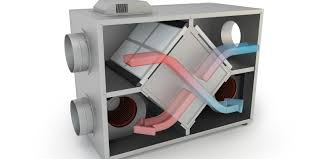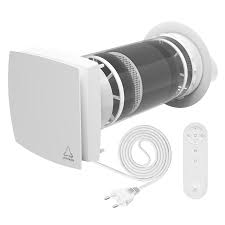Choose an ERV based on your climate (best for humid areas), the size of your home, and energy efficiency. Check for good air filters, low noise levels, and easy maintenance. Make sure the unit fits your installation needs—whole house or room-specific.
What are ERVs ?
What is an Energy Recovery Ventilator?
An Energy Recovery Ventilator (ERV) is a ventilation system that brings in fresh air while expelling stale air, helping improve indoor air quality and energy efficiency. It also transfers both heat and moisture between the incoming and outgoing air streams.
Unlike an HRV (Heat Recovery Ventilator), which transfers only heat, an ERV is designed to also regulate indoor humidity levels. It does this through a moisture-permeable heat exchanger, allowing the system to transfer some of the humidity from the more humid air stream to the drier one. This helps maintain a balanced indoor humidity level, reducing the need for additional humidification or dehumidification.

The Basics of ERVs
An Energy Recovery Ventilator (ERV) not only exchanges stale indoor air with fresh outdoor air but also significantly improves indoor air quality by continuously reducing pollutants, odors, and excess humidity. By transferring heat and moisture between incoming and outgoing air streams, ERVs help maintain comfortable humidity levels and reduce the workload on heating and cooling systems, which can lead to lower energy bills. They are especially useful in modern, tightly sealed buildings where natural ventilation is limited, providing fresh air without sacrificing energy efficiency. ERVs are environmentally friendly, helping reduce carbon emissions by saving energy, and are commonly used in homes, offices, schools, and hospitals. Unlike Heat Recovery Ventilators (HRVs), ERVs transfer both heat and moisture, making them ideal for humid climates.
HRVs vs. ERVs
ERV and HRV are both ventilation systems that improve indoor air quality and energy efficiency by exchanging indoor and outdoor air. The main difference is that ERVs transfer both heat and moisture, while HRVs only transfer heat. This makes each system suitable for different climate conditions.
ERV transfers heat and moisture; HRV transfers only heat.
ERV is ideal for humid or mixed climates.
HRV works best in cold, dry climates.


Why ERVs Important
An Energy Recovery Ventilator (ERV) is important because it helps maintain fresh, clean indoor air while saving energy. In modern, tightly sealed buildings, natural ventilation is limited, which can lead to a buildup of indoor pollutants and humidity. ERVs solve this by bringing in fresh air and exhausting stale air, all while transferring heat and moisture to reduce the strain on heating and cooling systems. This makes the indoor environment healthier, more comfortable, and more energy-efficient.
How do ERVs work?
Stale indoor air is exhausted outside while fresh outdoor air is brought inside.
Both air streams pass through the ERV core without mixing.
Heat and moisture transfer from the warmer air to the cooler air.
Incoming air is pre-conditioned—warmed and humidified in winter, cooled and dehumidified in summer.
This process saves energy and keeps indoor air comfortable.
Choosing an ERV
ERV Installation Services
At High Class, we provide expert ERV installation, repair, and maintenance services to help you achieve balanced indoor air quality with humidity regulation. ERVs are ideal for homes and buildings where both temperature and moisture control are essential—especially in moderate to warm climates.
Custom System Design
We assess your property’s square footage, insulation, and existing HVAC setup to recommend the right ERV model with suitable airflow capacity (CFM).Strategic Placement & Mounting
The ERV unit is professionally mounted in a mechanical room, attic, or crawl space for optimal accessibility and performance.Ductwork & Ventilation Integration
We install dedicated supply and exhaust ducts, or connect the ERV to your existing system, ensuring fresh air is delivered to living spaces and stale air is drawn from moisture-prone areas.Humidity & Airflow Balancing
Our team calibrates the ERV to optimize both temperature and moisture transfer, helping you avoid dry winter air or excess humidity in summer.Control Setup & User Guidance
We install and configure digital or wall-mounted ERV controllers, and walk you through how to manage settings for seasonal efficiency.
ERV Repair & Diagnostic Services
Low or No Airflow
We inspect fans, filters, and core components to resolve ventilation blockages or motor issues.Imbalanced Humidity Levels
If your home feels too dry or too humid, we check the moisture transfer core, airflow balance, and sensor calibration.Control Panel Malfunctions
We repair or replace malfunctioning controls and troubleshoot wiring issues to restore full functionality.Unusual Noise or Odor
We examine the fan assembly, check for microbial buildup, and clean or replace filters and the core as needed.
ERV Replacement & System Modernization
Over time, even high-quality ERVs can become outdated, less efficient, or too noisy for modern comfort expectations. We offer tailored upgrade solutions that enhance indoor air quality, control humidity more precisely, and improve overall energy performance.
Our replacement services feature:
High-Efficiency Moisture Transfer Cores
Advanced core designs improve both heat and humidity exchange, reducing the burden on your HVAC system year-round.Low-Noise, High-Performance Fans
New-generation fans offer quiet operation without compromising airflow or efficiency.Smart Automation & Climate Control
Upgrade to models with intuitive controls, scheduling features, and app integration for seamless remote access and performance tracking.Energy-Saving Technology
Replace aging equipment with models designed to meet today’s energy standards and reduce your monthly utility bills.
Long-Term ERV Maintenance & Care
ERVs operate best with consistent care—especially in homes dealing with high humidity or allergen concerns. Our maintenance services are designed to extend the system’s lifespan, improve air quality, and ensure quiet, reliable ventilation in every season.
Our detailed ERV care includes:
Filter Management
Inspecting and replacing intake and exhaust filters to prevent clogging and maintain airflow (typically every 3–6 months).Moisture Core Cleaning
Safely removing and cleaning the energy core to ensure optimal heat and humidity transfer.Drain & Condensate Line Flushing
Clearing buildup to avoid mold growth and maintain proper drainage from the unit.Airflow & Humidity Calibration
Adjusting ventilation rates and rebalancing the system for seasonally efficient operation.Full System Inspection
Annual performance reviews including fan motor checks, control diagnostics, and mechanical wear assessments.
FAQs
How does an ERV save energy?
By transferring heat and moisture between incoming and outgoing air, an ERV reduces the load on heating and cooling systems, lowering energy consumption.
Do I need an ERV for my home?
If your home is well-sealed and located in a humid or mixed climate, an ERV helps maintain fresh air and balanced humidity efficiently.
How often should an ERV be maintained?
Regular maintenance, like cleaning or replacing filters and inspecting the core, should be done every 6 to 12 months to ensure optimal performance.
Testimonials
Honest Reviews from our Customers

Jane Anderson
Homeowner, San Diego
“The team at Earthly Elegance totally transformed our backyard into a stunning oasis. Their attention to detail and creativity exceeded our expectations!”
Ready to transform your outdoor space?
Contact us today to schedule a consultation or to learn more about our services.

